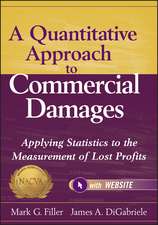Strict Liability: Legal and Economic Analysis
Autor Frank J. Vandallen Limba Engleză Hardback – 30 sep 1989
This volume presents a cogent analysis of the legal and economic consequences arising from expansion in the doctrine of strict liability and the corresponding decrease in the importance of proving fault. Vandall's goal is to illuminate the role of strict liability in the largely unheralded and informal development of the American compensation system. To this end, he examines and explains the widening of strict liability during the last 121 years, with particular emphasis on the past 29 years.
Vandall begins with a historical overview of strict liability, arguing that the policies which have supported the growth of strict liability within products liability also support its application in other areas. By comparing and contrasting the U.S. and British compensation systems, he shows that the U.S. has been drawn towards the adoption of strict liability because it lacks socialized medicine. Subsequent chapters set forth various tests for strict liability and critique the negligence-efficiency theory. Turning to a discussion of contemporary practice, Vandall sets out the present scope of strict liability and asserts that a case can be made for the extension of strict liability far beyond the area of products liability. Finally, Vandall evaluates the reforms aimed at strict liability over the last ten years and concludes that the suggested return to negligence is unwarranted and not supported by facts.
Preț: 437.47 lei
Preț vechi: 604.04 lei
-28% Nou
83.74€ • 90.99$ • 70.38£
Carte tipărită la comandă
Livrare economică 21 aprilie-05 mai
Specificații
ISBN-10: 089930396X
Pagini: 195
Dimensiuni: 155 x 248 x 20 mm
Greutate: 0.5 kg
Editura: Praeger
Descriere
Vandall begins with a historical overview of strict liability, arguing that the policies which have supported the growth of strict liability within products liability also support its application in other areas. By comparing and contrasting the U.S. and British compensation systems, he shows that the U.S. has been drawn towards the adoption of strict liability because it lacks socialized medicine. Subsequent chapters set forth various tests for strict liability and critique the negligence-efficiency theory. Turning to a discussion of contemporary practice, Vandall sets out the present scope of strict liability and asserts that a case can be made for the extension of strict liability far beyond the area of products liability. Finally, Vandall evaluates the reforms aimed at strict liability over the last ten years and concludes that the suggested return to negligence is unwarranted and not supported by facts.





















